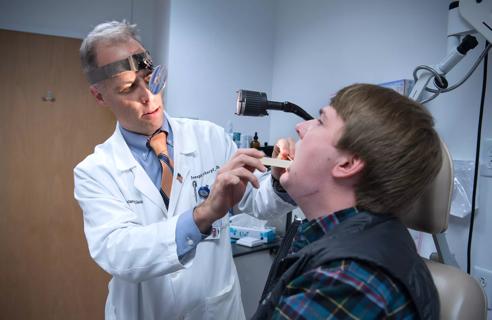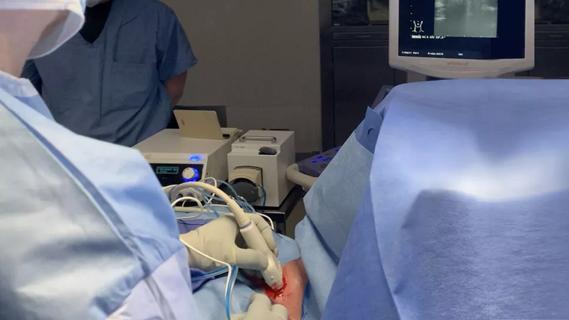A new study indicates that the combined approaches can be performed without mortality and with acceptable morbidity

Newly published research indicates that advanced thyroid disease involving the mediastinum may be managed with combined transcervical and transthoracic surgery without significant mortality and acceptable morbidity. Transthoracic surgery via sternotomy, manubrietcomy or thoracotomy for thyroid cancer is rarely performed in contemporary surgical practice since most superior mediastinal disease can be effectively removed with a traditional transcervical approach. However, patients requiring transthoracic surgery for thyroid cancer often have disease that is extensive and/or treatment-resistant. Therefore, a combined transcervical and transthoracic approach is needed to remove the disease entirely and to perform the procedure safely.
Advertisement
Cleveland Clinic is a non-profit academic medical center. Advertising on our site helps support our mission. We do not endorse non-Cleveland Clinic products or services. Policy
“Thyroid cancer can involve the mediastinum due to lymph node metastasis or direct extension from the thyroid itself,” explains Natalie Silver, MD, MS, Director of Head and Neck Cancer Research at Cleveland Clinic Head and Neck Institute and corresponding author on the study. “Most of the time, cancer can be removed through a neck incision, but sometimes we need to combine the neck incision with transthoracic approaches that can give us access to the mediastinal structures. Because of the technical complexity involved with managing mediastinal thyroid disease, we wanted to better understand the associated outcomes involved with a combined transcervical and transthoracic surgical approach.”
Dr. Silver notes that the primary objective of the study was to investigate the patient characteristics as well as the extent and safety of transthoracic surgery for patients with aggressive thyroid cancer. Secondary objectives were to evaluate the overall survival (OS) and locoregional disease-free survival (LR-DFS) in the cohort and identify factors associated with these outcomes.
The retrospective study included data from 38 patients who were treated with transthoracic surgery for thyroid malignancy between December 1, 1994, and May 31, 2015, at a single high-volume institution. The median age of the patient cohort was 59 years (range 28-76), and the majority were male (63%) and white (76%). Twenty-three (61%) patients were seen with primary disease, and among patients with recurrent disease, all had undergone at least a thyroid lobectomy. Recurrence was identified at the primary site (13%), lateral neck (40%), central neck (33%) and in the mediastinum (67%). The most common sites of distant metastasis were the lungs, bone, liver and brain.
Advertisement
“The majority of patients were seen with distant metastases beyond the mediastinum,” says Dr. Silver. “However, most were deemed to have locoregionally curable disease with a meaningful impact on quality of life, so they were, therefore, good candidates for surgery.”
Transthoracic surgery was accomplished through one of three approaches based on the extent and location of the disease: 24 patients (63%) received sternotomy, 10 patients (26%) received manubriectomy and four received (11%) thoracotomy.
Eighteen patients had transthoracic procedures for resection of the primary malignancy, and 25 patients had the procedure to remove mediastinal lymph node(s). In addition to a transthoracic procedure, patients also required lateral neck dissection (61%), central neck dissection (68%) and mediastinal lymph node dissection (82%).
“Due to the aggressive nature of the disease present in our cohort, many of our patients’ local structures were impacted,” says Dr. Silver. “This required several procedures to remove disease including internal jugular vein sacrifice, recurrent laryngeal nerve sacrifice, vagus nerve resection, phrenic nerve resection, segmental tracheal resection, partial or full thickness esophageal resection and laryngectomy.”
Adjuvant treatment was administered based on final pathology, with a total of 62% of patients receiving adjuvant treatment. Specific postoperative adjuvant therapies included radioactive iodine (RAI) alone (18% of the overall cohort), external beam radiation therapy (XRT) alone (21%), RAI plus XRT (21%), cytotoxic chemotherapy (8%), and/or targeted therapy (3%). Metastatic mediastinal lymph nodes were removed in 81% of patients, and the median number of positive lymph nodes was 2 (range 0–31).
Advertisement
One-year OS was 84% and the 1-year LR-DFS was 64%. The median time to locoregional recurrence was 36 months. Only esophageal invasion was associated with worse oncologic outcomes. Based on univariate log-rank testing, the only statistically significant measure of disease extent, tumor histology, treatment rendered or patient characteristic was that esophageal invasion was associated with worse OS (19% 5-year OS vs. 67% without invasion; p = 0.009).
“In our cohort, the most common associated complication was hypoparathyroidism — 39% of patients experienced temporary hypoparathyroidism, and 18% experienced permanent hypoparathyroidism,” says Dr. Silver. “However, surgical techniques can be employed to minimize the risk of permanent hypoparathyroidism and should be considered in high-risk patients such as those undergoing transthoracic surgery, including identification of parathyroid tissue using indocyanine-green (ICG) infrared imaging or autofluorescence imaging.”
She continues, “This also reinforces the advantage of high-volume institutions when they are experienced in these surgical techniques. A multidisciplinary team is also recommended since management of mediastinal thyroid disease can be technically challenging. A head and neck surgeon, thoracic surgeon, medical oncologist, endocrinologist, and occasionally a head and neck reconstructive surgeon should be included in the care team.”
Dr. Silver notes that these findings show that a combined transcervical and transthoracic approach for advanced cases of thyroid cancer involving the mediastinum, can be performed safely with an experienced medical team.
Advertisement
Advertisement

Studies find mTOR inhibitor may play key role in treating Hurthle cell carcinoma

Only 33% of patients have long-term improvement after treatment

Strong communication with the patient and a thorough approach are essential

OMT may be right for some with Graves’ eye disease

Radiofrequency ablation significantly reduces symptom severity, shrinks nodules

Timing and type of side effects differ greatly from chemotherapy

Cleveland Clinic researchers pursue answers on basic science and clinical fronts

Interventions abound for active and stable phases of TED